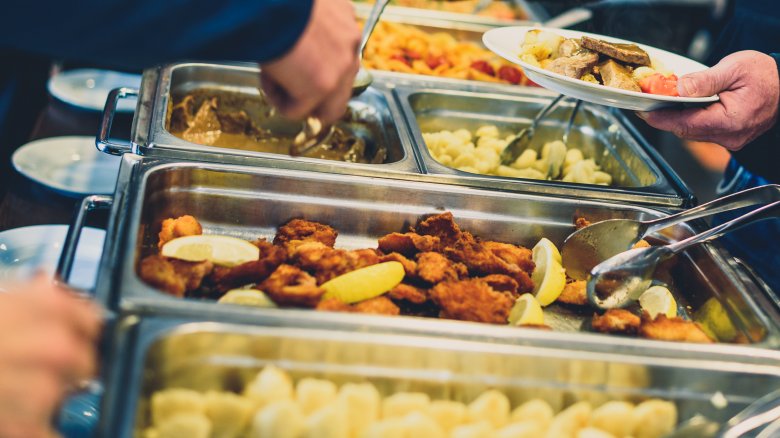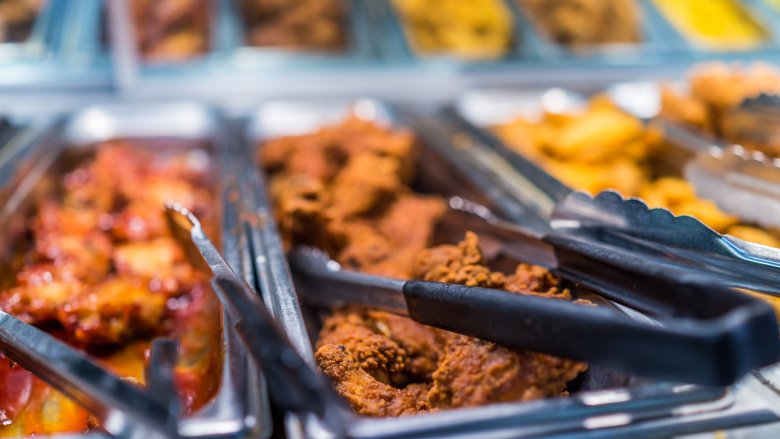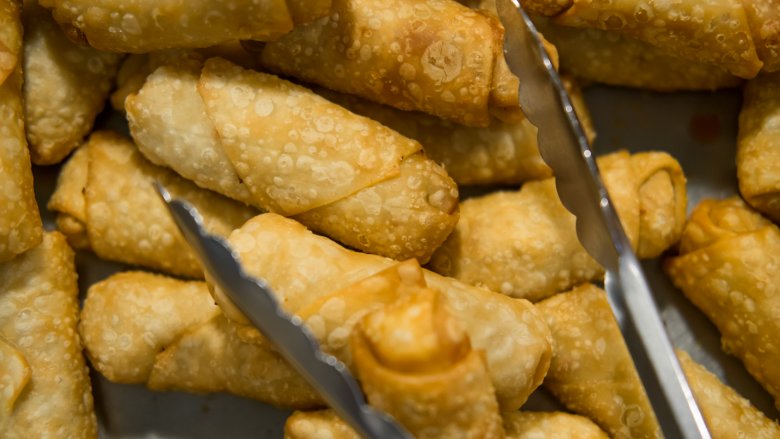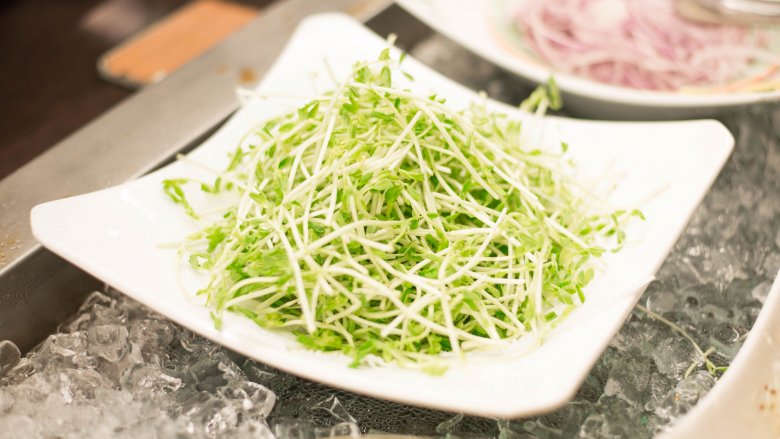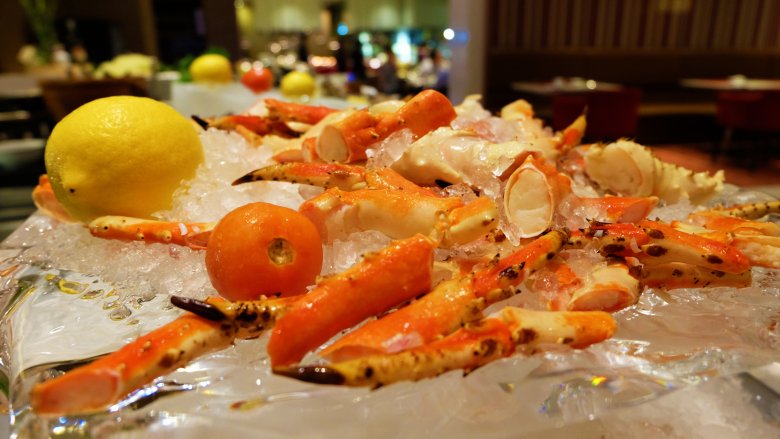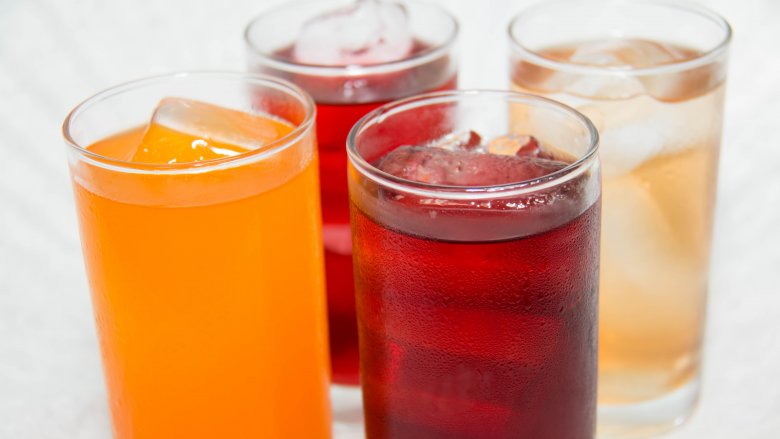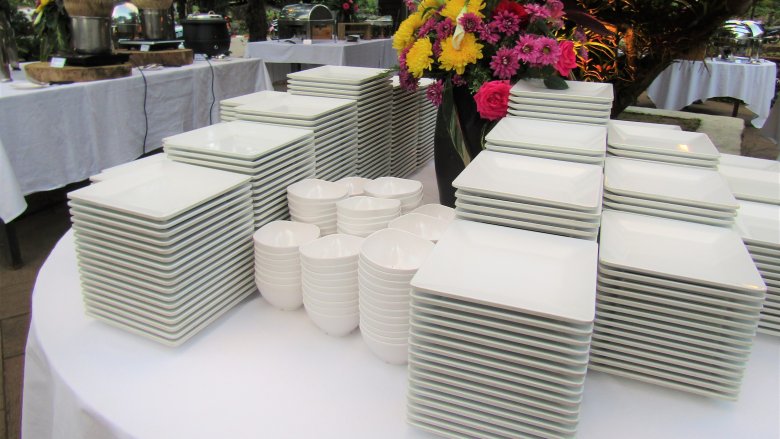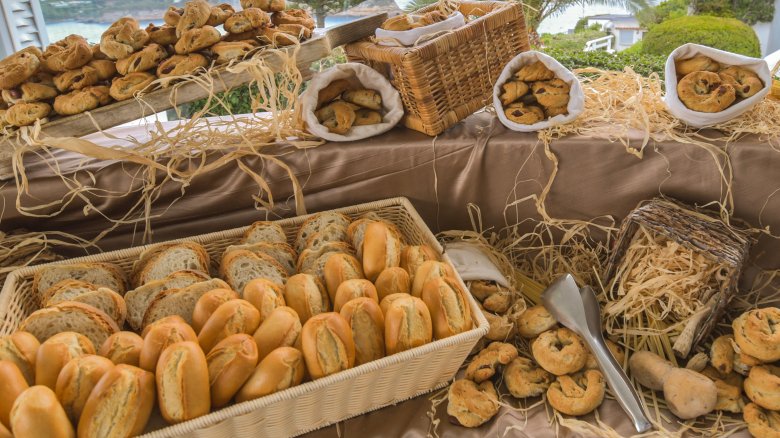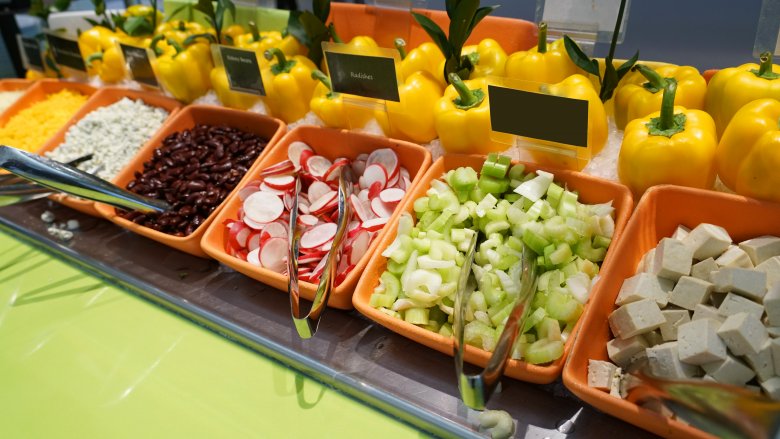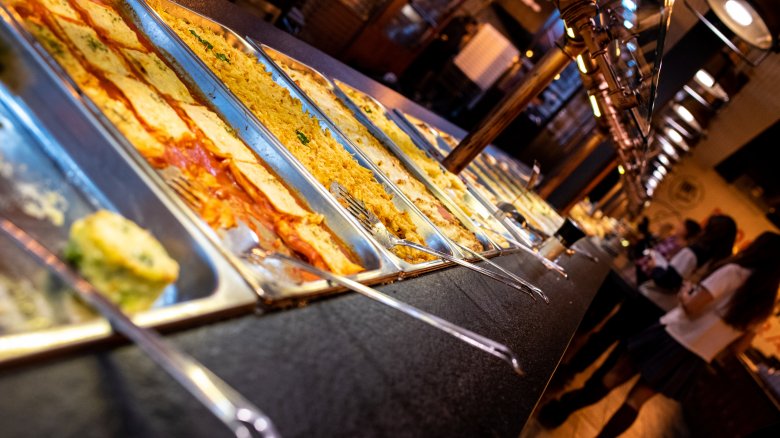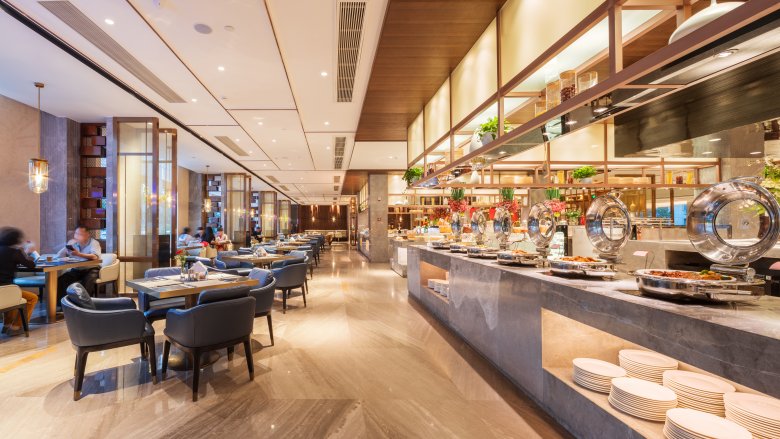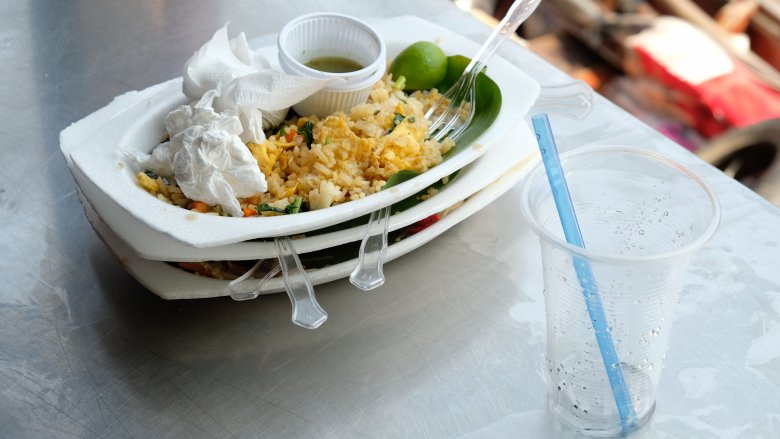Mistakes Everyone Makes When Eating At Buffets
It doesn't matter what your intentions are when you go to a buffet, or how fancy of a buffet you choose, they're always a bit of a minefield.
Whether you're trying to make sure you get your money's worth, if you're trying to get in and out without ruining your healthy eating plan, or if you're just hoping to avoid that bout of food poisoning you left with on your last trip, it's tough to know just what to choose and how to choose it.
Buffets have all kinds of tricks up their sleeve when it comes to guiding you toward what they want you to eat, and knowing that is only half the battle. Sure, you might know that they front-load the buffet line with cheap fillers like rice and put the good, more expensive stuff farther down the line, but there's still probably a few mistakes you're making. Some are surprising and some will even apply to your favorite sit-down restaurant, so let's talk about what you need to know to get the most out of your trip to the buffet — no matter what your goals are.
Grabbing the fried food
It's so, so tough to resist grabbing a few pieces of fried chicken or loading up a plate with those crispy, delicious egg rolls, but according to Rene Ficek, RN, of Seattle Sutton's Healthy Eating (via Reader's Digest), loading up on fried goodness is definitely a mistake. But not exactly for the reason you think. All fried food is bad, but buffet fried food is even worse.
Why? Because buffets are cooking everything in bulk, and they're going to try to cut back on their costs where they can. That means they're using the cheapest oil they can find to fill their fryers, which churns out fried dishes that are likely to have the maximum amount of artery-clogging nastiness possible. "Every time you put something in a deep fryer, it acts like a sponge and soaks up as much grease and saturated and trans fat as possible," Ficek explains. Doesn't sound so appetizing now, does it?
Plus, look at it this way — that fried chicken has probably been sitting under the lights for a while, and we all know fried food is best when it's super fresh. If you're going to splurge, splurge on the best possible and skip the buffet's fried offerings.
Choosing your favorites
When you hit the buffet, what sort of food do you tend to gravitate toward? Do you go for the tried-and-true favorites, the things you know you're going to like, or do you try something new? If you're only loading up your plate with the stuff you know you're going to like and the dishes you've had before, you're missing out, says Delishably.
Buffets are the perfect opportunity to try something new, without making a commitment to a dish. It's not like a sit-down restaurant where ordering something you've never had before can make or break your evening, and you're not actually investing some of your hard-earned cash into something you're not sure if you're going to like. Get a small plate, try a few spoonfuls of something new, and who knows — you might just go back for seconds (and thirds).
Also, consider this: are you loading up your plate with food you make at home? Don't do that! Go for something different, and not only will you feel like you're getting your money's worth, but you won't be comparing it to your own home cooking.
Opting for foods likely to make you sick
Not all buffet foods are created equal. Vice says around 128,000 people end up in the hospital with food poisoning each and every year, and if it seems like buffets are just germ collectors, they can be... but they don't have to be. It's all down to your choices, and if you're not careful, you could be opting for foods that that are more likely than others to be dangerous. Here's some guidelines as to what you shouldn't be eating, according to the health and food safety experts that spoke with Reader's Digest.
Don't put sprouts on your salad, because they're known bacteria-carriers in even the best and cleanest of kitchens. The same goes for sushi — while it might be tempting, preparing it and keeping it at the right temperature while it's sitting on a buffet line is difficult at best. Also skip the tuna, which is more susceptible to bacterial growth than other types of fish, and skip anything with mayo in it for the same reason. (Sorry, that includes creamy salad dressings.)
What about the seafood? That's a whole other issue.
Piling plates with crab legs and oysters
Hitting the buffet and going right to the seafood section might seem like a good idea, especially if it's piled high with things you just don't get often, like oysters and crab legs. But there are a few reasons you should think about skipping these, and the first is obvious: the potential for some serious food poisoning, as MedlinePlus says shellfish and fish are both extremely susceptible to contamination.
There's something else to consider, too, and it comes from an all-you-can-eat buffet operator who took to Reddit to dispel some mysteries about the buffet. When someone asked what food they would stay away from at all costs, the answer was "crab legs".
"I'm being serious," the poster continued. "I have seen Chinese buffets at the fish market going and buying bottom of the barrel seafood, including crab legs past their prime. And then they don't steam them properly either to save on volume."
The Redditor also adds that oysters are usually less-than-fresh, often imported and past their prime once they make it to the buffet table. If you're not skipping these, you might be risking a trip to the hospital.
Drinking anything but water
It might seem only natural that you're going to order a round of sodas to sip on while you're hitting the buffet, but this is another mistake you shouldn't make for a few reasons.
According to Psychology Today, those giant glasses are there for a reason — they encourage you to drink a lot, fill up on soft drinks, and ultimately have less room for food. Soft drinks cost the buffet next to nothing, and it's a super cheap way to help make sure you're leaving with a full belly — at a minimal cost to them.
You know soft drinks are marked up, you expect that when you go to any restaurant. But you might not realize just how much the price goes up with you sit down to be served. According to Business Insider, soft drinks are one of the biggest ways restaurants cash in, and the average markup on soda is a whopping 1,150 percent. For buffets, it's a double whammy — they're making money, and they're hoping you won't eat as much food. Skip the soda, grab a water, and say "no, thank you" to that free refill.
Using the plates and utensils nearby
For most people, their instinct is to grab the plates sitting at the head of the table and use them for whatever is on that buffet line. But there's absolutely no reason to do that, especially considering those plates and bowls are specifically put out for a reason — to trick you into eating less of the good stuff and more of the cheap stuff.
Psychology Today says that the size of utensils and plates used at buffets are chosen because they control how much food you can take at one time. There's even specially-sized "buffet line" products, and by the end of your meal the small plate sizes and huge glasses mean you've filled up on things you didn't intend to.
So, scout utensils and tableware when you scout the buffet line. If salad plates are bigger, grab one of those for your meat-and-veg course. If the soup bowls are bigger than the dessert bowls, grab one for ice cream. Even if you have no intentions of eating more and filling these bigger plates, it'll be much, much easier to keep from making the inevitable mess that seems to come with those tiny plates.
Opting for the starches
Buffets operate on something called the "Fill the Customer Belly Cheaply" metric, says Psychology Today. The ideal buffet foods are cheap for them to buy, easy to make, and extremely filling — which means starches are often in abundance. Keep an eye out next time, and you'll see there will be piles and piles of rice, noodles, and bread — all of which are cheap and filling. They're tempting, too, but if you're going heavy on these starches, you're not doing yourself any favors.
Skip things like dinner rolls and bread completely, as they're going to fill you up fast — and you can enjoy those anywhere. Food Network warns against not just those more obviously filling starches, but also against things like potatoes, pasta salads, and rice pilaf. Buffets make it easy to serve yourself huge helpings of things like these — usually by giving customers larger serving spoons — so be aware of just how many starches and carbs you're putting on your plate, then save room for the less filling, more expensive stuff.
Dropping a serving spoon and putting it back
So, you're picking out the choicest morsels and putting them on your plate. Have you ever picked a serving spoon that's laying in the rice or the lettuce, then used it? Or, have you ever dropped a serving utensil into a dish, then picked it up and propped it on the side of the serving tray? You're not helping yourself or other customers, and here's why this is a huge mistake.
According to Food Safety News, there's a pretty glaring gap in food safety regulations that impact buffets in particular. Restaurants need to conform to a whole checklist of safety standards, but there are not as many rules and regulations regarding serving utensils. Those tongs and spoons can be touched by hundreds of people in just a few hours' time. When those handles are dropped into food, all the germs that have collected on them are dropped into the tray, too. Regulations say if a utensil is dropped into a platter, the entire platter should be replaced... bur if you pick it up and put it back where it goes quickly, they'll never know.
Even if you're super careful about washing your hands, not everyone else is. Your best bet is to not only skip anything that has a utensil laying in it, but tell staff so they can fix a potential health hazard.
Not scouting first and making a plan
When you get to the buffet, do you grab a plate and hop right in line? You shouldn't, you should scout out the buffet before you even pick up a plate.
Even if you've been to that particular buffet before, dishes and layouts are always changing, says Psychology Today, and the only way to really get what you want is to make a plan ahead of time.
You'll find any new or seasonal dishes that are on offer, and you'll be able to figure out what you're going to put on your first plate, second plate, and so on. And why's that important? Flavor profiles: you don't want to be piling chicken teriyaki alongside a slice of roast beef and gravy, do you? This can go the other way, too. Say you're starting with a salad, but since you've wandered through the rest of the line, maybe you've found a pan of grilled chicken you can slice and add to the salad. So take a minute, walk the lines, and see what you feel like having — you'll minimize waste and regret.
Not timing your trip very carefully
When one Redditor asked others for their go-to buffet strategies, there was one in particular that was pretty brilliant. So brilliant, in fact, that everyone should be planning their buffet trips this way, because if you're not, you're missing out.
If the buffet serves different meals for lunch and dinner, head in and grab a chair about half an hour before the switch. If you go in when it's still lunchtime, you'll probably be paying the cheaper lunchtime price. Start with picking out a plate of lunchtime foods, but don't fill up because it's only a matter of time before staff swap over the buffet tables and put out steaming dishes of hot, fresh dinner items.
(Other commenters do stress that this might not work for all buffets, especially those that charge you after you eat. Do a little research, and eat both lunch and dinner to your heart's content!)
Skipping meals before you go
Everyone wants to get their money's worth when they're going to a buffet, and it might be tempting to skip breakfast and lunch in preparation for a dinner buffet, but this is actually a terrible idea — just take it from the competitive eaters over at Food Challenges.
They know just how quickly your body — and your stomach — reacts when it's deprived of food. Long periods without food cause your stomach to shrink, because it's essentially learning to survive on less. Skip your morning and afternoon meals, and by the time you head to the buffet, it'll have been a full day since you've eaten anything. There's less room in your smaller stomach, and you probably won't be feeling that great. Ultimately, it'll lead to a case of "eyes-bigger-than-stomach," which is pretty common at buffets, anyway.
Instead, have a light meal in the morning in preparation. It'll set you up right for getting your money's worth.
Missing the "kids-eat-free" window of opportunity
Buffets are perfect for families with children. Everyone can have whatever they want, after all, and there's bound to be something for an adventurous eater and a picky eater alike. The only thing better than a dinner where everyone's happy is a dinner where the kids eat free (or almost free), and many buffets offer that option — if you time your visit correctly. Are you? If not, you're throwing money away.
While some places offer free meals for toddlers (with adult purchases), there's also deals like Golden Corral's limited-run Kids' Nights. During those promotions, older kids — between 4 and 12 — can help themselves to the buffet and get a drink for just 99 cents. You'll have to go after 4 p.m. Monday through Saturday and after 11 a.m. on Sunday, so skip the lunch buffet and opt for dinner. Hometown Buffet does something similar, and offers kids aged 4 to 11 a $1.99 buffet after 4 p.m. Pizza buffets usually have deals on their kids' meals, too, so call ahead, ask, and stop missing out on some serious savings.
Contributing to food waste
Food waste is a widespread problem that exists on a scale almost too big to fathom, so taking too much at a buffet and leaving a half-full plate to be thrown away is a bigger mistake than you might expect.
In 2017, Forbes reported studies done at hotel buffets revealed some shocking statistics: a little over half the food put out on buffet lines ended up in the garbage. And it's a global problem. Winnow uncovered similar findings when they looked at buffets in Asia, where they found that again, about half of the food served at a buffet was wasted.
The problem is complicated, and waste happens not just on customers' uneaten plates. Have you ever skipped over a tray because there's only a single scoop or so left? Why? The habit has given rise to buffet's tendencies to replace trays before they're empty, and that's all food going right in the garbage. Here's how you make a difference: take that last scoop, and pace yourself. Make an extra trip if you're still hungry instead of piling your plate high and not eating it all. Every little bit counts, and when it comes to food waste, everyone can make a difference.
